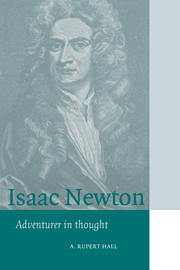Book contents
- Frontmatter
- Contents
- List of Figures
- General Editor's Preface
- Foreword
- Acknowledgement
- 1 The Hopeful Youth, 1642–1664
- 2 “The prime of my age for invention”, 1664–1667
- 3 Widening Horizons, 1667–1669
- 4 The Professor of Mathematics, 1669–1673
- 5 Publication and Polemic, 1672–1678
- 6 Life in Cambridge, 1675–1685
- 7 The Chemical Philosopher, 1669–1695
- 8 The Mathematical Principles of Natural Philosophy, 1679–1687
- 9 Private and Public life, 1685–1696
- 10 Fluxions and Fury, 1677–1712
- 11 Opticks, or a Treatise of Light, 1687–1704
- 12 Life in London, 1696–1718
- 13 A Man of Authority and Learning, 1692–1727
- 14 Later Books, 1706–1726
- 15 Kensington, 1725–1727
- Appendices
- A Newton's Alchemical Studies and his Idea of the Atomic Structure of Matter
- B Newton's Portraits
- C Newton's London Homes
- D Jonathan Swift and Catherine Barton
- E The Fate of Newton's Papers and his Library
- Notes
- Bibliography
- Index
B - Newton's Portraits
Published online by Cambridge University Press: 12 January 2010
- Frontmatter
- Contents
- List of Figures
- General Editor's Preface
- Foreword
- Acknowledgement
- 1 The Hopeful Youth, 1642–1664
- 2 “The prime of my age for invention”, 1664–1667
- 3 Widening Horizons, 1667–1669
- 4 The Professor of Mathematics, 1669–1673
- 5 Publication and Polemic, 1672–1678
- 6 Life in Cambridge, 1675–1685
- 7 The Chemical Philosopher, 1669–1695
- 8 The Mathematical Principles of Natural Philosophy, 1679–1687
- 9 Private and Public life, 1685–1696
- 10 Fluxions and Fury, 1677–1712
- 11 Opticks, or a Treatise of Light, 1687–1704
- 12 Life in London, 1696–1718
- 13 A Man of Authority and Learning, 1692–1727
- 14 Later Books, 1706–1726
- 15 Kensington, 1725–1727
- Appendices
- A Newton's Alchemical Studies and his Idea of the Atomic Structure of Matter
- B Newton's Portraits
- C Newton's London Homes
- D Jonathan Swift and Catherine Barton
- E The Fate of Newton's Papers and his Library
- Notes
- Bibliography
- Index
Summary
Newton was painted at least seventeen times by seven or more artists: Sir Godfrey Kneller depicted him four times, Sir James Thornhill and John Vanderbank twice. In addition one may examine a death mask, ivory medallions made by David Le Marchand at various dates and an excellent medal in profile (1726) by Newton's Mint artist, John Croker. All these images of Newton, except the 1689 Kneller (of which at least two versions exist) were made after Newton's move to London, hence after the age of sixty (Kneller, 1702). Many of the portraits were engraved and widely circulated.
Three of especial interest are the 1689 Kneller painting of Newton with a youthful, alert, intellectual appearance, of which the original has always been in the family; the 1720 Kneller painted for Pierre Varignon; and the 1725 Vanderbank, commissioned by the Royal Society and still hanging in its rooms.
Of the second, showing Newton at the age of seventy-eight, Varignon remarked that he appeared no more than fifty years old, yet Brook Taylor had assured him of its excellence as a likeness. Stukeley, present at the ‘sittings’ for this portrait, wrote that ‘it was no little entertainment to hear the discourse that passed between these two first men in their way. tho it was Sir Isaac's temper to say little, yet it was one of Sir Godfrey's arts to keep up a perpetual discourse, to preserve the lines and spirit of a face’ (Memoirs, 1936, pp. 12–13). This portrait was later acquired in Paris by Lord Egremont and now hangs at Petworth.
- Type
- Chapter
- Information
- Isaac NewtonAdventurer in Thought, pp. 387 - 388Publisher: Cambridge University PressPrint publication year: 1996

